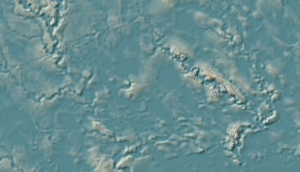Difference between revisions of "Groundwater"
Jenny Hill (talk | contribs) (Created page with "<poem> Where possible, it is recommended that infiltration BMPs maintain a 1.0 m vertical separation above the seasonally high groundwater table. Retention of this unsat...") |
Jenny Hill (talk | contribs) |
||
| (25 intermediate revisions by 2 users not shown) | |||
| Line 1: | Line 1: | ||
| − | + | ||
| − | + | ==Target groundwater separation== | |
| − | Retention of | + | In many areas of Ontario the target separation between the base of an exfiltrating LID practice and the water table is 1.0 m. |
| + | This is to mitigate risks due to short periods of groundwater mounding and potentially unobserved seasonal fluctuations. In areas where a 1.0 m separation cannot be provided, or where conditions dictate that an even greater separation may be warranted, additional discussion and/or analysis specific to the physical characteristics of the site and the proposed design should be completed. | ||
| + | The design practitioner is advised to consult with approval agencies to understand their requirements and/or expectations prior to undertaking work, and to complete an appropriate level of analysis to support their conclusion. The requirement for additional investigation and/or documentation supporting a proposed design may be reduced in areas where ≥ 1.0 m separation is anticipated. | ||
| + | |||
| + | Retention of an unsaturated zone beneath the practice : | ||
*Minimizes the potential for functional impacts associated with reduced percolation rates, | *Minimizes the potential for functional impacts associated with reduced percolation rates, | ||
| − | *Maintains the physical and biochemical water quality treatment benefits provided within the vadose zone | + | *Maintains the physical and biochemical water quality treatment benefits provided within the vadose zone. |
| − | + | ||
| − | + | ==Groundwater mounding== | |
| − | + | Groundwater mounding describes the localised raising of the water table beneath infiltration practices. It may be of concern if it affects nearby structures including building foundations. | |
| − | + | When you wish to model the extent of groundwater mounding beneath an infiltration facility. This tool uses Hantush's derivation (1967). | |
| − | The | + | |
| − | + | {{Clickable button|[[Media:Hantush.xlsm|Download groundwater mounding calculator(.xlsm)]]}} | |
| + | |||
| + | Note that this is a minor adaptation (metric units and formatting) from the original tool, written and [https://pubs.usgs.gov/sir/2010/5102/ hosted by the USGS]. | ||
| + | |||
| + | ===Preventing groundwater interaction=== | ||
| + | Many LID systems rely upon reuse, or evaporation and transpiration instead of infiltration to the ground. If the site cannot support any infiltration, consider | ||
| + | *[[Rainwater harvesting]], | ||
| + | *[[Flow-through planters]], | ||
| + | *[[Green roofs]], or | ||
| + | *[[Blue roofs]]. | ||
| + | |||
| + | ==Oak Ridges Moraine Groundwater Monitoring Program== | ||
| + | [[File:ORMGP.JPG|thumb|Depth to groundwater raster and contours from the ORMGP]] | ||
| + | https://oakridgeswater.ca/ | ||
| + | |||
| + | The Oak Ridges Moraine focused program stretches from the Credit and Nottawasaga Watersheds in the west to the Trent River in the east and reaches from the shores of Lake Ontario northwards to beyond Lake Simcoe and the Kawartha Lakes. Within the publicly accessible maps section there is a depth to groundwater map layer. | ||
| + | |||
| + | ===Other sources of groundwater data=== | ||
| + | *[http://ontariogroundwater.com/ Ontario groundwater] | ||
| + | *[https://www.ontario.ca/environment-and-energy/map-provincial-groundwater-monitoring-network Provincial groundwater monitoring network map] | ||
| + | ---- | ||
Revision as of 19:49, 1 August 2019
Target groundwater separation[edit]
In many areas of Ontario the target separation between the base of an exfiltrating LID practice and the water table is 1.0 m. This is to mitigate risks due to short periods of groundwater mounding and potentially unobserved seasonal fluctuations. In areas where a 1.0 m separation cannot be provided, or where conditions dictate that an even greater separation may be warranted, additional discussion and/or analysis specific to the physical characteristics of the site and the proposed design should be completed. The design practitioner is advised to consult with approval agencies to understand their requirements and/or expectations prior to undertaking work, and to complete an appropriate level of analysis to support their conclusion. The requirement for additional investigation and/or documentation supporting a proposed design may be reduced in areas where ≥ 1.0 m separation is anticipated.
Retention of an unsaturated zone beneath the practice :
- Minimizes the potential for functional impacts associated with reduced percolation rates,
- Maintains the physical and biochemical water quality treatment benefits provided within the vadose zone.
Groundwater mounding[edit]
Groundwater mounding describes the localised raising of the water table beneath infiltration practices. It may be of concern if it affects nearby structures including building foundations. When you wish to model the extent of groundwater mounding beneath an infiltration facility. This tool uses Hantush's derivation (1967).
Note that this is a minor adaptation (metric units and formatting) from the original tool, written and hosted by the USGS.
Preventing groundwater interaction[edit]
Many LID systems rely upon reuse, or evaporation and transpiration instead of infiltration to the ground. If the site cannot support any infiltration, consider
Oak Ridges Moraine Groundwater Monitoring Program[edit]
The Oak Ridges Moraine focused program stretches from the Credit and Nottawasaga Watersheds in the west to the Trent River in the east and reaches from the shores of Lake Ontario northwards to beyond Lake Simcoe and the Kawartha Lakes. Within the publicly accessible maps section there is a depth to groundwater map layer.
